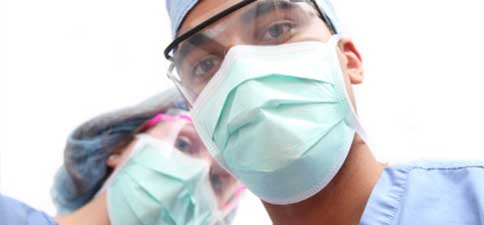» Anti-Aging
» Bones Joints & Muscle Health
» Cardiovascular Health
- Hip And Knee Joint Replacements: The Infection Risks
- All About Excessive Sweating & How To Stop Hyperhidrosis Sweats Ruining Your Life
- Should You Be Worried About Diabetic Retinopathy? Find Out If You Are Developing & How To Prevent It
- Must Know Lyme Disease Information - You Might Be Surprised To Find Out...
- Do You Have Sleep Apnea? Find Out What It Is And How To Treat It
» Chronic Pain Management
» Dental Health & Wellness
» Digestive Health Problems
» Health Care
» Mental Health
» Sexual Health
» Skin Care

Hip And Knee Joint Replacements: The Infection Risks
Hip and knee replacement surgeries have become commonplace, and can often help boost both mobility and quality of life. While serious complications are rare, the very nature of the implanted hardware makes an infection following surgery particularly devastating.
Both the patient and their caregivers — most commonly family members and other loved ones — suffer greatly when a surgical site or the implant itself becomes infected. Treatment almost always requires hospitalization and intravenous antibiotic therapy. Additional surgery is often necessary, including removal of the hardware. Intensive inpatient rehabilitation may be needed. Even with insurance or Medicare, out-of-pocket costs can add up quickly.
How Common Are Joint Replacements?
As long as you have a doctor you trust, there is no reason to fear undergoing a knee or hip replacement procedure. Both are commonly performed elective operations, and most people recover fairly quickly and are able to participate in activities after surgery that they couldn’t do for a decade or more before (OrthoInfo).
More than 285,000 hip replacement procedures are performed in the U.S. each year, according to statistics compiled by the Agency for Healthcare Research and Quality (OrthoInfo: Total Hip Replacement). Since its introduction in 1960, a total hip replacement has helped millions of Americans live fuller, more active lives.
The same can be said for knee replacement procedures. Although introduced in 1968, the knee replacements of today are much more effective than those performed in the early years. In fact, according to the Agency for Healthcare Research and Quality, about 600,000 successful total knee replacements are now performed in the United States annually (OrthoInfo: Total Knee Replacement).
While it is true that most who have a joint replacement operation are between the ages of 50 and 80, each case is evaluated individually. A doctor will only recommend this type of elective surgery when a patient’s disability and pain level make it worth the risks.
How Common Are Infections After Joint Replacement?
While hip and knee replacements are routine procedures, they are still major surgeries. They have, however, become much safer through the years. The infection rate was an astounding 14 percent in the early years of the implants according to a Hospital for Special Surgery report. Today, though, the chances of developing an infection in the initial recovery period is only about 1 percent according to OrthoInfo.
Once the incision is healed, however, you aren’t free and clear. Infections can occur around joint implants months or even years after surgery. The lifetime risk of developing an infection around an artificial knee or hip falls between 1 and 4 percent (HSS).
Late, or delayed, infections often occur after bacteria enters the body through a cut or during major dental work such as a root canal. The materials used to make artificial joints provides a safe haven for this bacteria to grow, allowing them to multiply quickly.
Infections in an artificial joint — whether they occur during, soon after surgery, or later on — often necessitate an operation known as a total joint revision to cure the infection and replace the implant. Each year, there are approximately 80,000 revision procedures performed in the United States due to this type of implant failure according to Medscape.
Recent Infection Concerns Raised Over Infected Joint Contamination During Implant
Further compounding the concerns over infections, recent litigation against a surgical device commonly used during joint implant procedures have been raised. Legal complaints against the 3M Bair Hugger patient warmer system allege the device may have needlessly increased the risk for deep joint infections in implant patients when contaminated air is blown over the surgical wound and new joint to be implanted during the surgical procedure (LawsuitLegal).
A study was published and found the system increased airborne contaminants by as much as 2000 times according to the Bone & Joint Journal. At this time, attorneys investigating the hip & knee infection lawsuit claims to rise in the months to come as patients who may have compensation waiting for them come forward (PRNewswire).
How Are Infections In An Artificial Joint Treated?
Occasionally an infection is recognized extremely early, and can be treated through intravenous antibiotics alone. Unfortunately, though, by the time symptoms develop the infection has usually reached the artificial joint and even IV antibiotics aren’t strong enough to stop it from spreading. Once the infection reaches the implant, it almost always requires some type of surgical treatment (Oxford Journal).
Infections that appear within a few weeks of surgery or those that are delayed but diagnosed within days of onset may be cured through a debridement procedure. This surgical procedure cleans the area around the joint, including removing any affected soft tissues. After this operation, antibiotics will be prescribed for six weeks. In some cases, IV antibiotics are used.
If this procedure isn’t effective, or if the infection has been present for a week or more, a revision is often required. This includes two staged surgeries. During the first procedure, the implant is removed, and the area is cleaned as in a debridement. Then, a specially designed spacer that contains antibiotics is placed in the area where the artificial joint was removed. This will offer limited comfort and mobility between surgeries. A course of IV or oral antibiotics will follow.
During the second step of the revision process, the space is removed and a new implant is placed. This surgery usually takes place at least six to eight weeks after the initial step. After the second total joint replacement surgery, patient often require intensive physical therapy and rehabilitation. In some cases, care in a skilled nursing facility may be necessary.
Can The Risk of Infection Be Reduced?
There are a number of things that doctors can do to help reduce a patient’s risk of infection after a joint replacement. By implementing certain protocols before, during and after the operation, the surgeon and care team can minimize the risk of introducing bacteria to the incision, and help to prevent the growth of bacteria during healing (Medscape).
Before surgery, the area should be properly prepared using an alcohol-based antiseptic agent. Some doctors even recommend patients shower with special soaps that contain chlorhexidine gluconate for the three days prior to surgery. If they have been screened for staph and found to be carrier, they may be treated with intranasal mupirocin as well (IHI: Surgical Site Inspections).
Once in the operating room, patients should be given prophylactic antibiotics before surgery, and for the next 24 hours. The proper procedures must be in place in the operating room, including limiting the foot traffic that enters the room during the procedure. All instruments must be properly sterilized, and strict sterile techniques must be followed. Some types of drapes and warming blankets have also been shown to increase the risk of infection during joint replacement procedures, and should be avoided.
Postoperative wound care also plays an important role in infection prevention. Finally, the American Academy of Orthopaedic Surgeons suggests antibiotic prophylaxis prior to any future surgery or dental work that many allow bacteria to be introduced into the body (OrthoInfo).
It’s also important to note that some people are at an increased risk of developing any infection, including those that affect an artificial joint. This includes those with diabetes or peripheral vascular disease. People with immune deficiencies or who must be on immunosuppressive treatments should also discuss their increased risk of postoperative infection with their doctors before deciding if a joint replacement is the best choice for them.
What Can I Do To Take Charge Of My Care?
If you’re planning to have a hip or knee replacement procedure, it is important to discuss all aspects of the surgery with your doctor. This should include how to minimize the risk of infection.
You May Also Find Informative:
Aging Fit - Health Research & Information
Better Health. Energy. Quality.






